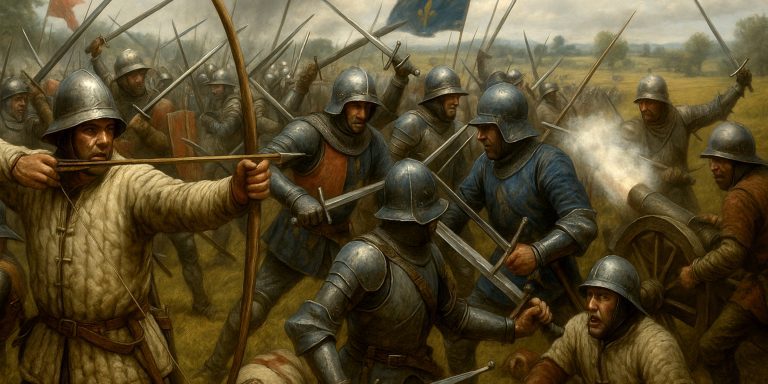
Compact, sharp and built with purpose, the Tanto blade is one of the most recognisable weapons from Japan’s armoury. It sits at the crossroads of utility and status, shaped by centuries of craftsmanship. Although small, it carries the same spirit as the larger katana and wakizashi, just channelled into a weapon designed for thrusting, cutting and surviving the rough edges of close combat.
This guide breaks down its specifications, origins and evolution, along with practical notes for modern collectors.
Specifications
Typical Measurements
| Feature | Range |
|---|---|
| Overall Length | 25 to 30 cm |
| Blade Length | 15 to 25 cm |
| Blade Thickness | 4 to 6 mm |
| Sugata (shape) | Hira-zukuri or moroha-zukuri |
| Hamon | Straight or midare patterns |
| Materials | High carbon tamahagane steel with differential hardening |
Construction Features
- Single or double edged depending on school
- Often without a ridge line, giving the blade smooth, uninterrupted planes
- Tang usually short and secured with one mekugi pin
- Can feature ornate koshirae when used as a status piece
History and Evolution
The Tanto emerged in the Heian period as a straightforward sidearm for nobles and warriors. Early blades were slim and elegant. As warfare intensified in the Kamakura and Muromachi periods, the blade grew broader, thicker and more suited to armour-piercing thrusts. Samurai carried it both as a practical tool and a symbol of preparedness.
By the Edo period it took on a new role in ceremony and fashion. Many Tanto from this era are highly decorated, intended more for display than the battlefield.
Modern Tanto blades, especially those made outside Japan, often reinterpret the design with thicker profiles and tactical finishes aimed at outdoor use rather than ritual or combat.
Advantages and Disadvantages
Advantages
- Easy to carry and conceal
- Strong point suited to piercing armour gaps
- Durable construction, often with thick spines
- Straightforward to maintain compared with longer swords
- Highly collectable, especially signed antique blades
Disadvantages
- Short reach limits combat versatility
- Certain blade shapes are harder to sharpen for beginners
- High quality antiques can be expensive and require specialist care
Comparison with Similar Weapons
| Weapon | Length | Primary Use | Key Difference from Tanto |
|---|---|---|---|
| Wakizashi | 30 to 60 cm | Secondary sword | Longer reach, used as part of the daisho |
| Aikuchi | 20 to 30 cm | Concealed blade | No guard, often slimmer and more decorative |
| Kaiken | 20 to 25 cm | Personal defence | Traditionally carried by women, plainer fittings |
| Pugio (Roman) | 20 to 30 cm | Military sidearm | Leaf shaped blade rather than a pointed geometry |
| Seax | Variable | Everyday tool and weapon | Straight back design with different regional forms |
Legacy
The Tanto earned its place in Japanese martial culture through utility and symbolism. Its compact size and reliable form made it an essential companion weapon. It appears in a range of historical tales, clan regalia and religious offerings.
Modern martial artists still study Tanto defence and disarming techniques. In popular culture the silhouette remains instantly recognisable, often used in contemporary knife design across the world.
==================================================
Where to See Authentic Tanto Blades
- Tokyo National Museum
- Kyoto National Museum
- Sano Art Museum, Mishima
- British Museum, London
- Met Museum, New York
- Museum of Fine Arts, Boston
Many exhibitions rotate their sword displays, so checking current curation schedules is helpful.
Collector’s Guide
What Collectors Look For
- Signed blades from famous smiths
- Kamakura and Muromachi period workmanship
- Healthy polish with visible hamon
- Original koshirae with matching fittings
- Papers from NBTHK or NTHK authentication bodies
Condition Factors
- Chips or fatal flaws greatly reduce value
- Repeated heavy polishing can thin the blade
- Altered tangs reduce historical integrity
Typical Auction Prices
| Quality | Era | Price Range |
|---|---|---|
| Entry level unsigned | Late Edo | 700 to 1,200 GBP |
| Mid tier signed | Edo or Muromachi | 1,500 to 4,000 GBP |
| High quality with papers | Kamakura to Muromachi | 5,000 to 15,000 GBP |
| Rare smiths or koshirae sets | Various | 20,000 GBP and above |
Prices vary with polish, rarity, and provenance.
Buying Tips
- Purchase blades only from reputable dealers
- Request authentication papers or expert appraisal
- Consider total restoration cost before bidding
- Store in a cool, dry setting with a light coating of choji oil
The Tanto is a compact weapon with a long story behind it. Whether viewed as a tool, a piece of art or a symbol of warrior culture, it remains one of the most important small blades in Japanese history.



